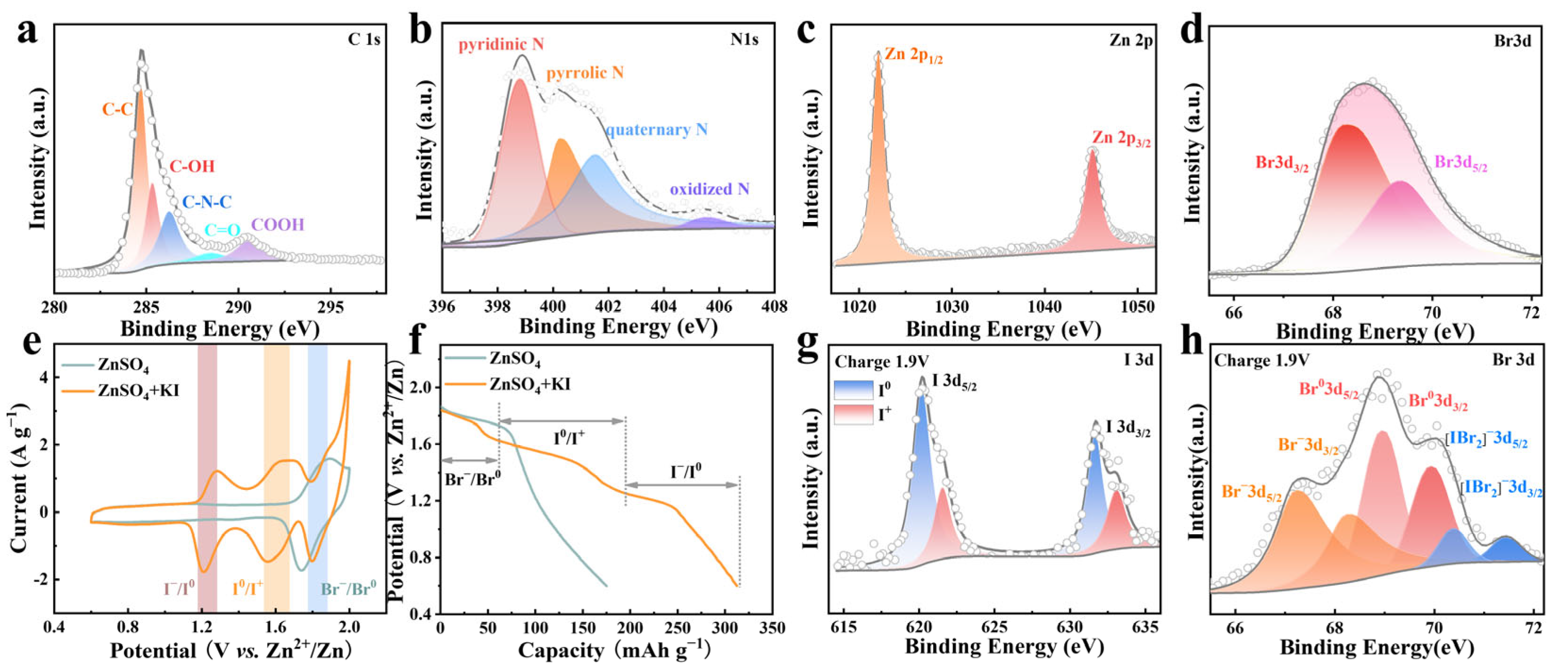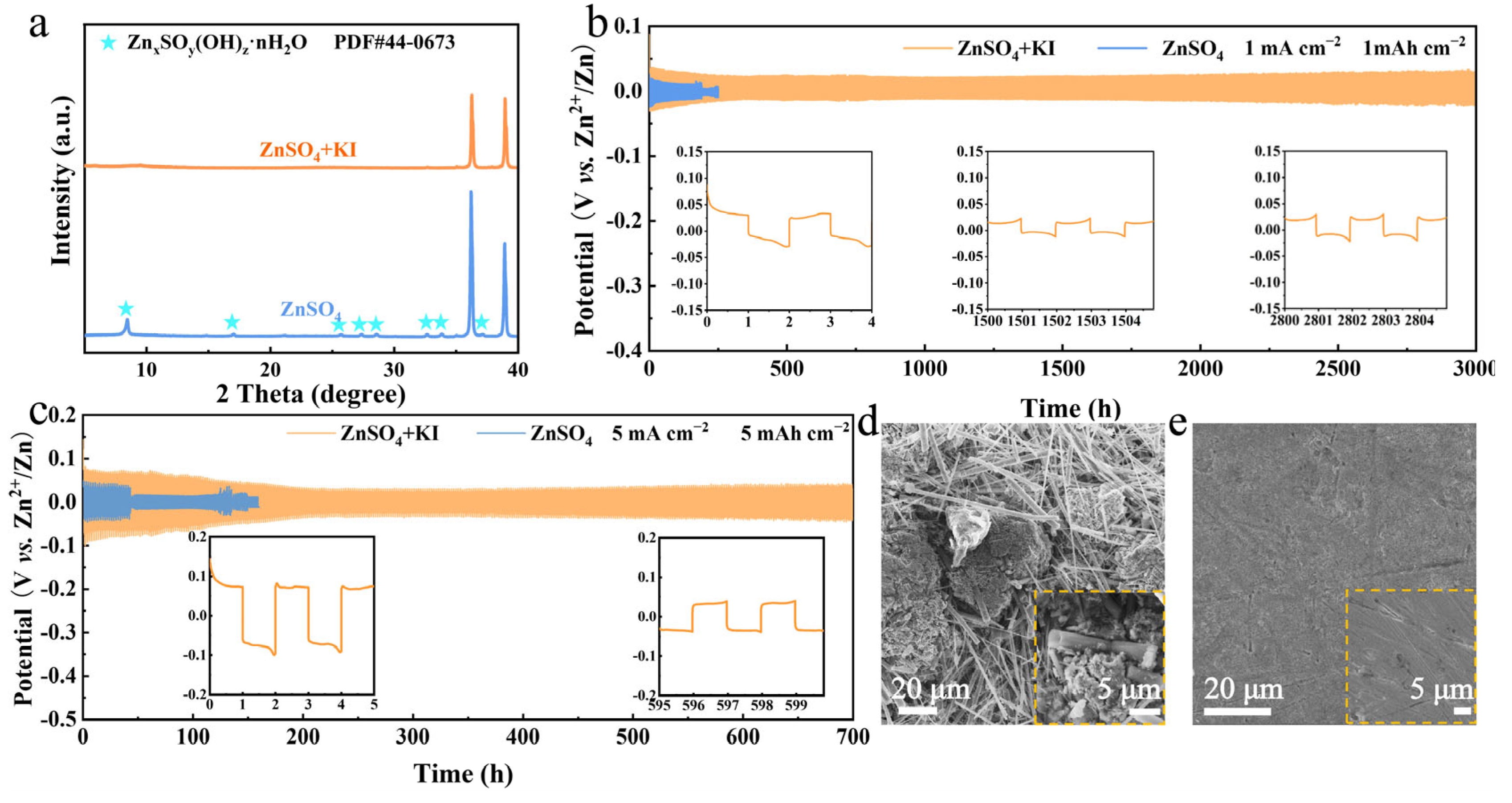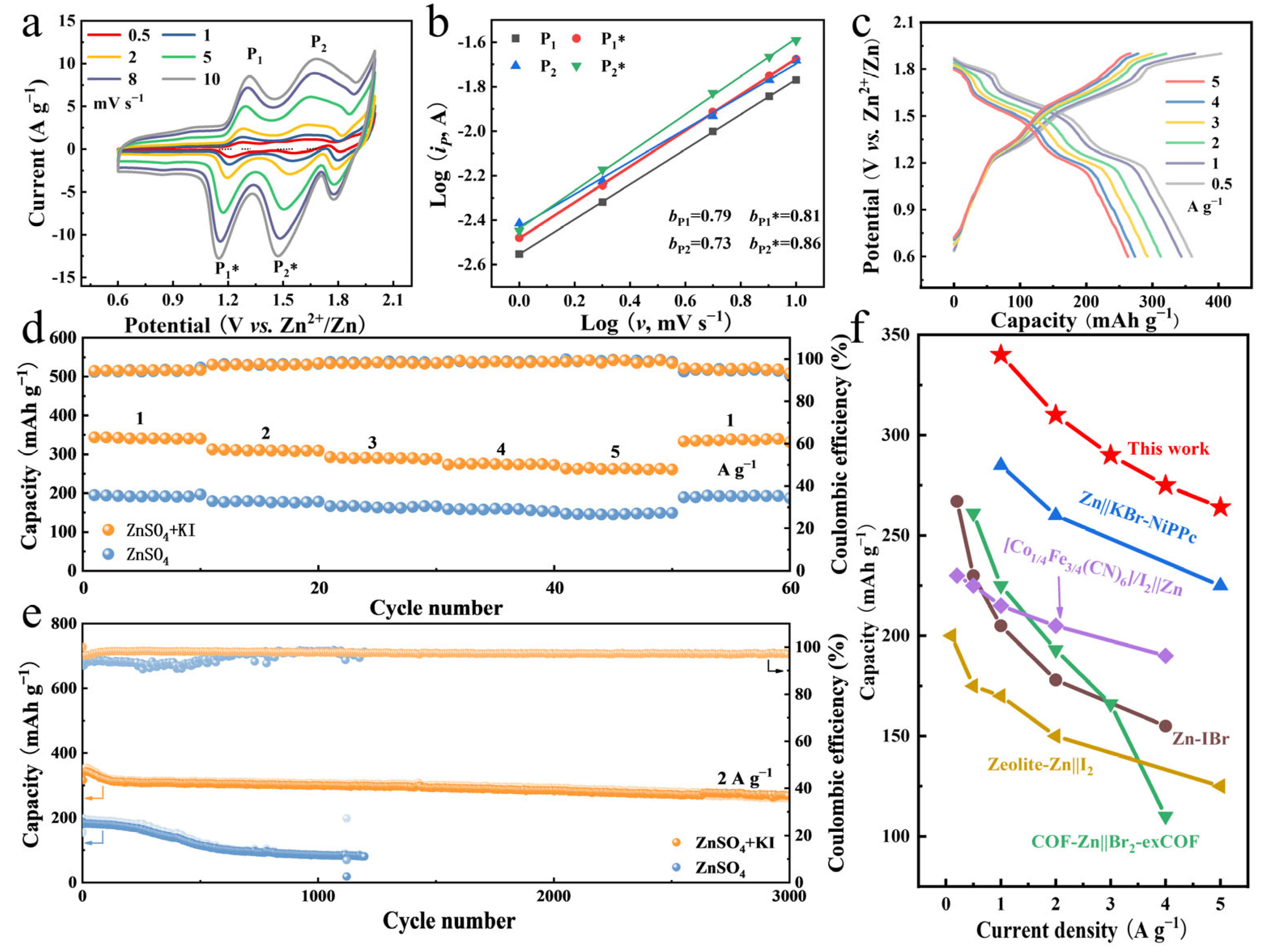Enabling a Reversible Six-Electron Redox Reaction Based on I−/I+ and Br−/Br0 for Aqueous Zinc-Bromine Batteries
Abstract
1. Introduction
2. Materials and Methods
2.1. Experimental Section
2.2. Material Characterization
2.3. Electrochemical Measurements
3. Results and Discussion
4. Conclusions
Supplementary Materials
Author Contributions
Funding
Data Availability Statement
Acknowledgments
Conflicts of Interest
References
- Liu, Z.; Wang, R.; Ma, Q.; Wan, J.; Zhang, S.; Zhang, L.; Li, H.; Luo, Q.; Wu, J.; Zhou, T.; et al. A dual-functional organic electrolyte additive with regulating suitable overpotential for building highly reversible aqueous zinc ion batterie. Adv. Funct. Mater. 2024, 34, 2214568. [Google Scholar] [CrossRef]
- Shang, Y.; Kundu, D. A path forward for the translational development of aqueous zinc-ion batteries. Joule 2023, 7, 244–250. [Google Scholar] [CrossRef]
- Li, D.; Li, C.; Liu, W.; Bu, H.; Zhang, X.; Li, T.; Zhang, J.; Kong, M.; Wang, X.; Wang, C.; et al. Constructing a multifunctional SEI layer enhancing kinetics and stabilizing zinc metal anode. Adv. Funct. Mater. 2024, 35, 2415107. [Google Scholar] [CrossRef]
- Li, G.; Sun, L.; Zhang, S.; Zhang, C.; Jin, H.; Davey, K.; Liang, G.; Liu, S.; Mao, J.; Guo, Z. Developing cathode materials for aqueous zinc ion batteries: Challenges and practical prospects. Adv. Funct. Mater. 2024, 35, 2301291. [Google Scholar] [CrossRef]
- Qu, G.; Wang, L.; Zhao, Y.; Wang, D.; Zhang, X.; Wang, B.; Wang, F.; Jing, Z.; Xu, X.; Xu, L.; et al. Anionic chemistry modulation enabled environmental self-charging aqueous zinc batteries: The case of carbonate ions. Angew. Chem. Int. Ed. 2024, 63, e202409774. [Google Scholar] [CrossRef]
- Kim, Y.; Park, Y.; Kim, M.; Lee, J.; Kim, K.J.; Choi, J. Corrosion as the origin of limited lifetime of vanadium oxide-based aqueous zinc ion batteries. Nat. Commun. 2022, 13, 2371. [Google Scholar] [CrossRef]
- Han, W.; Li, J.Z.X. Ternary chloride-free electrolyte design for highly efficient aqueous zinc–iodine batteries with four-electron conversion. Inorg. Chem. Front. 2024, 11, 5376–5383. [Google Scholar] [CrossRef]
- Wang, K.; Li, H.; Xu, Z.; Liu, Y.; Ge, M.; Wang, H.; Lu, Y.; Liu, J.; Zhang, Y.; Tang, Y.; et al. An iodine-chemisorption binder for high-loading and shuttle-free Zn-iodine batteries. Adv. Energy Mater. 2024, 24, 2304110. [Google Scholar] [CrossRef]
- Wang, F.; Liang, W.; Liu, X.; Yin, T.; Chen, Z.; Yan, Z.; Li, F.; Liu, W.; Lu, J.; Yang, C.; et al. A bifunctional electrolyte additive features preferential coordination with iodine toward ultralong-life zinc-iodine batteries. Adv. Energy Mater. 2024, 14, 2400110. [Google Scholar] [CrossRef]
- Liang, G.; Liang, B.; Chen, A.; Zhu, J.; Li, Q.; Huang, Z.; Li, X.; Wang, Y.; Wang, X.; Xiong, B.; et al. Development of rechargeable high-energy hybrid zinc-iodine aqueous batteries exploiting reversible chlorine-based redox reaction. Nat. Commun. 2023, 14, 1856. [Google Scholar] [CrossRef]
- Wang, C.; Ji, X.; Liang, J.; Zhao, S.; Zhang, X.; Qu, G.; Shao, W.; Lin, C.; Zhao, G.; Xu, X.; et al. Activating and stabilizing a reversible four electron redox reaction of I−/I+ for aqueous Zn iodine battery. Angew. Chem. Int. Ed. 2024, 63, e202403187. [Google Scholar] [CrossRef] [PubMed]
- Li, Q.; Abdalla, K.; Xiong, J.; Song, Z.; Wang, Y.; Zhao, Y.; Liu, M.; Fan, Y.; Zhao, Y.; Sun, X.M. High-energy and durable aqueous Zn batteries enabled by multi-electron transfer reactions. Energy Mater. 2024, 4, 400040. [Google Scholar] [CrossRef]
- Kim, M.; Yun, D.; Jeon, J. Effect of a bromine complex agent on electrochemical performances of zinc electrodeposition and electrode dissolution in zinc-bromide flow battery. J. Power Sources 2019, 438, 227020. [Google Scholar] [CrossRef]
- Liu, C.; Dong, W.; Zhou, H.; Li, J.; Du, H.; Ji, X.; Cheng, S. Achievement of efficient and stable non-flow zinc-bromine batteries assisted by rational decoration upon the two electrodes. ACS Appl. Mater. Interfaces 2024, 16, 23278–23287. [Google Scholar] [CrossRef]
- Lee, J.; Byun, Y.; Jeong, G.H.; Choi, C.; Kwen, J.; Kim, R.; Kim, I.H.; Kim, S.O.; Kim, H. High-energy efficiency membraneless flowless Zn–Br battery: Utilizing the electrochemical–chemical growth of polybromides. Adv. Mater. 2019, 31, 1904524. [Google Scholar] [CrossRef]
- Wang, C.; Xie, Q.; Wang, G.; Lyu, Y.; Wang, Q.; Ma, X.; Wang, H.; Guo, T.; Wu, Y.; Han, J. Visualizing and understanding the ionic liquid-mediated polybromide electrochemistry for aqueous zinc-bromine redox batteries. Nano Lett. 2024, 24, 13796–13804. [Google Scholar] [CrossRef]
- Wang, Q.; Dou, Q.; Deng, G.; Li, G.; Ma, Y.; Tang, P.; Cui, Y.; Yang, C.; Zang, L.; Yan, X. A hybrid-aqueous biphasic electrolyte for suppressed shuttle effects and self-discharge of zinc bromide batteries. J. Mater. Chem. A 2024, 12, 15658–15665. [Google Scholar] [CrossRef]
- Hao, J.; Zhang, S.; Wu, H.; Yuan, L.; Davey, K.; Qiao, S. Advanced cathodes for aqueous Zn batteries beyond Zn2+ intercalation. Chem. Soc. Rev. 2024, 53, 4312. [Google Scholar] [CrossRef]
- Cai, Z.; Wang, J.; Sun, Y. Anode corrosion in aqueous Zn metal batteries. eScience 2023, 3, 100093. [Google Scholar] [CrossRef]
- Tan, L.; Wei, J.; Xue, L.; Luo, D.; Chen, G.; Chu, Y.; Wang, J.; Zong, K.; Song, X.; Yang, L.; et al. Regulating the electron structure of covalent organic frameworks to enable excellent cycle life and high rate toward advanced Zn−I2 Batteries. Adv. Funct. Mater. 2025, 35, 2416931. [Google Scholar] [CrossRef]
- Xu, C.; Lei, C.; Jiang, P.; Yang, W.; Ma, W.; He, X.; Liang, X. Practical high-energy aqueous zinc-bromine static batteries enabled by synergistic exclusion-complexation chemistry. Joule 2024, 8, 461–481. [Google Scholar] [CrossRef]
- Liu, Z.; Gao, B.; Li, Y.; Liu, H.; Kamali, A. ZIF-8 decorated on three-dimensional graphene as reusable magnetic adsorbent for efficient removal of malachite green from wastewater. J. Mater. Sci. Technol. 2025, 1017, 179028. [Google Scholar] [CrossRef]
- Li, L.; Liu, J.; Yu, R.; He, R.; Chen, J.; Ma, H.; Zhang, L.; Mai, L.; Zhou, L. Encapsulating Si nanoparticles in ZIF-8-derived carbon through surface amination for stable lithium storage. J. Mater. Sci. Technol. 2025, 216, 93–98. [Google Scholar] [CrossRef]
- Zhao, T.; Yu, J.; Xiao, P.; Nie, S.; Peng, S.; Chen, J.; Luo, F.; Janiak, C.; Chen, Y. Preparation of hierarchical porous ZIF-67 and its application in zinc battery separator. Chemistry 2024, 6, 1363–1373. [Google Scholar] [CrossRef]
- Zhao, X.; Hao, J.; Chen, Q.; Zhang, S.; Wu, H.; Mao, L.; Qiao, S. Aqueous zinc-bromine battery with highly reversible bromine conversion chemistry. Angew. Chem. Int. Ed. 2025, e202502386. [Google Scholar] [CrossRef]
- Liu, T.; Wang, H.; Lei, C.; Mao, Y.; Wang, H.; He, X.; Liang, X. Recognition of the catalytic activities of graphitic N for zinc-iodine batteries. Energy Storage Matter. 2022, 53, 544–551. [Google Scholar] [CrossRef]
- Ponrouch, A.; Dedryvère, R.; Monti, D.; Demet, A.E.; Mba, J.M.A.; Croguennec, L.; Masquelier, C.; Johanssoncf, P.; Palacín, M.R. Towards high energy density sodium ion batteries through electrolyte optimization. Energy Environ. Sci. 2013, 6, 2361–2369. [Google Scholar] [CrossRef]
- Jiang, X.; He, S.; Han, G.; Long, J.; Li, S.; Lau, C.; Zhang, S.; Shao, L. Aqueous one-step modulation for synthesizing monodispersed ZIF-8 nanocrystals for mixed-matrix membrane. ACS Appl. Mater. Interfaces 2021, 13, 11296–11305. [Google Scholar] [CrossRef]
- Zhang, X.; Wang, X.; Qu, G.; Wang, T.; Zhao, X.; Fan, J.; Han, C.; Xu, X.; Zhi, C.; Li, H. Reversible solid-liquid conversion enabled by self-capture effect for stable non-flow zinc-bromine batteries. Green Energy Environ. 2024, 9, 1035–1044. [Google Scholar] [CrossRef]
- Xu, J.; Wang, J.; Ge, L.; Sun, J.; Ma, W.; Ren, M.; Cai, X.; Liu, W.; Yao, J. ZIF-8 derived porous carbon to mitigate shuttle effect for high performance aqueous zinc–iodine batteries. J. Colloid Inter. Sci. 2022, 610, 98–105. [Google Scholar] [CrossRef]
- Rana, M.; Kim, M.J.; Peng, L.; Lim, H.; Kaiser, R.; Ran, L.; Luo, B.; Han, Z.; Hossain, M.; Lu, X.; et al. Impact of micropores and dopants to mitigate lithium polysulfides shuttle over high surface area of ZIF-8 derived nanoporous carbons. ACS Appl. Energy Mater. 2020, 3, 5523–5532. [Google Scholar] [CrossRef]
- Yan, J.; Zheng, X.; Wei, C.; Sun, Z.; Zeng, K.; Sun, J.; Rümmeli, M.; Yang, R. Nitrogen-doped hollow carbon polyhedron derived from salt-encapsulated ZIF-8 for efficient oxygen reduction reaction. Carbon 2021, 171, 320–328. [Google Scholar] [CrossRef]
- Lv, S.; Fang, T.; Ding, Z.; Wang, Y.; Jiang, H.; Wei, C.; Zhou, D.; Tang, X.; Liu, X. A high-performance quasi-solid-state aqueous zinc−dual halogen battery. ACS Nano. 2022, 16, 10389–10399. [Google Scholar] [CrossRef]
- Chen, S.; Peng, C.; Zhu, D.; Zhi, C. Bifunctionally electrocatalytic bromine redox reaction by single-atom catalysts for high-performance zinc batteries. Adv. Mater. 2024, 36, 2409810. [Google Scholar] [CrossRef] [PubMed]
- Guo, S.; Wang, D.; Wang, J. ZIF-8@CsPbBr3 Nanocrystals Formed by Conversion of Pb to CsPbBr3 in Bimetallic MOFs for Enhanced Photocatalytic CO2 Reduction. Small Methods 2024, 8, 2301508. [Google Scholar] [CrossRef] [PubMed]
- Rana, M.; Kim, J.; Peng, L.; Qiu, H.; Kaiser, R.; Qiu, L.H.; Kaiser, R.; Ran, L.; Hossain, M.A.; Luo, B.; et al. ZIF-8 derived hollow carbon to trap polysulfides for high performance lithium-sulfur batteries. Nanoscale 2021, 13, 11086–11092. [Google Scholar] [CrossRef]
- Chen, S.; Ying, Y.; Wang, S.; Ma, L.; Huang, H.; Wang, X.; Jin, X.; Bai, S.; Zhi, C. Solid Interhalogen Compounds with Effective Br0 Fixing for Stable High-energy Zinc Batteries. Angew. Chem. Int. Ed. 2023, 62, e202301467. [Google Scholar] [CrossRef]
- Li, X.; Li, N.; Huang, Z.; Chen, Z.; Liang, G.; Yang, Q.; Li, M.; Zhao, Y.; Ma, L.; Dong, B.; et al. Enhanced Redox Kinetics and Duration of Aqueous I2/I− Conversion Chemistry by MXene Confinement. Adv. Mater. 2021, 33, 2006897. [Google Scholar] [CrossRef]
- Feng, Z.; Tang, Y.; Wei, Y.; He, J.; Liu, G.; Yan, J.; Qi, J.; Shi, Z.; Yang, Q.; Wen, Z.; et al. Reducing dead species by electrochemically-densified cathode-interface-reaction layer towards high-rate-endurable Zn||I-Br batteries. Angew. Chem. Int. Ed. 2024, 64, e202416755. [Google Scholar] [CrossRef]
- Shao, W.; Li, C.; Wang, C.; Du, G.; Zhao, S.; Qu, G.; Xing, Y.; Guo, T.; Li, H.; Xu, X. Stabilization of zinc anode by trace organic corrosion inhibitors for long lifespan. Chin. Chem. Lett. 2025, 36, 109531. [Google Scholar] [CrossRef]
- Li, C.; Zhang, X.; Qu, G.; Zhao, S.; Qin, H.; Li, D.; Li, N.; Wang, C.; Xu, X. Highly reversible Zn metal anode securing by functional electrolyte modulation. Adv. Energy Mater. 2024, 14, 2400872. [Google Scholar] [CrossRef]
- Wang, C.; Zhao, S.; Song, X.; Wang, N.; Peng, H.; Su, J.; Zeng, S.; Xu, X.; Yang, J. Suppressed dissolution and enhanced desolvation in core–shell MoO3@TiO2 nanorods as a high-rate and long-life anode material for proton batteries. Adv. Energy Mater. 2022, 12, 202200157. [Google Scholar] [CrossRef]
- Li, X.; Wang, Y.; Chen, Z.; Li, P.; Liang, G.; Huang, Z.; Yang, Q.; Chen, A.; Cui, H.; Dong, B.; et al. Two-electron redox chemistry enabled high-performance iodide ion conversion battery. Angew. Chem. Int. Ed. 2022, 61, e202113576. [Google Scholar] [CrossRef] [PubMed]
- Li, X.; Li, N.; Huang, Z.; Chen, Z.; Zhao, Y.; Liang, G.; Yang, Q.; Li, M.; Huang, Q.; Dong, B.; et al. Confining aqueous Zn-Br halide redox chemistry by Ti3C2TX Mxene. ACS Nano 2021, 15, 1718–1726. [Google Scholar] [CrossRef]
- Shang, W.; Li, Q.; Jiang, F.; Huang, B.; Song, J.; Yun, S.; Liu, X.; Kimura, H.; Liu, J.; Kang, L. Boosting Zn||I2 battery’s performance by coating a zeolite-based cation-exchange protecting layer. Nano-Micro Letts. 2022, 14, 82. [Google Scholar] [CrossRef]
- Ma, L.; Ying, Y.; Chen, S.; Huang, Z.; Li, X.; Huang, H.; Zhi, C. Electrocatalytic iodine reduction reaction enabled by aqueous zinc-iodine battery with improved power and energy densities. Angew. Chem. Int. Ed. 2021, 60, 3791–3798. [Google Scholar] [CrossRef]
- Meng, Z.; Qiu, Z.; Shi, Y.; Wang, S.; Zhang, G.; Pi, Y.; Pang, H. Micro/nano metal–organic frameworks meet energy chemistry: A review of materials synthesis and applications. eScience 2023, 3, 100092. [Google Scholar] [CrossRef]
- Xie, K.; Ren, K.; Wang, Q.; Lim, Y.; Ma, F.; Sun, C.; Li, Y.; Zhao, X.; Lai, C. In situ construction of zinc-rich polymeric solid–electrolyte interface for high-performance zinc anode. eScience 2023, 3, 100153. [Google Scholar] [CrossRef]
- Xue, Z.; Gao, Z.; Zhao, X. Halogen Storage Electrode Materials for Rechargeable Batteries. Energy Environ. Mater. 2022, 5, 1155–1179. [Google Scholar] [CrossRef]
- Lu, G.; Wang, Z.; Zhang, S.; Ding, J.; Luo, J.; Liu, X. Cathode materials for halide-based aqueous redox flow batteries: Recent progress and future perspectives. Nanoscale 2023, 15, 4250–4260. [Google Scholar] [CrossRef]




Disclaimer/Publisher’s Note: The statements, opinions and data contained in all publications are solely those of the individual author(s) and contributor(s) and not of MDPI and/or the editor(s). MDPI and/or the editor(s) disclaim responsibility for any injury to people or property resulting from any ideas, methods, instructions or products referred to in the content. |
© 2025 by the authors. Licensee MDPI, Basel, Switzerland. This article is an open access article distributed under the terms and conditions of the Creative Commons Attribution (CC BY) license (https://creativecommons.org/licenses/by/4.0/).
Share and Cite
Zhang, J.; Ji, X.; Yu, Q.; Zhang, X.; Li, C.; Li, N.; Kong, M.; Li, D.; Liu, W.; Wang, C.; et al. Enabling a Reversible Six-Electron Redox Reaction Based on I−/I+ and Br−/Br0 for Aqueous Zinc-Bromine Batteries. Chemistry 2025, 7, 75. https://doi.org/10.3390/chemistry7030075
Zhang J, Ji X, Yu Q, Zhang X, Li C, Li N, Kong M, Li D, Liu W, Wang C, et al. Enabling a Reversible Six-Electron Redox Reaction Based on I−/I+ and Br−/Br0 for Aqueous Zinc-Bromine Batteries. Chemistry. 2025; 7(3):75. https://doi.org/10.3390/chemistry7030075
Chicago/Turabian StyleZhang, Jing, Xiaoxing Ji, Qingxiu Yu, Xixi Zhang, Chuanlin Li, Na Li, Mengzhen Kong, Dingzheng Li, Wenjie Liu, Chenggang Wang, and et al. 2025. "Enabling a Reversible Six-Electron Redox Reaction Based on I−/I+ and Br−/Br0 for Aqueous Zinc-Bromine Batteries" Chemistry 7, no. 3: 75. https://doi.org/10.3390/chemistry7030075
APA StyleZhang, J., Ji, X., Yu, Q., Zhang, X., Li, C., Li, N., Kong, M., Li, D., Liu, W., Wang, C., & Xu, X. (2025). Enabling a Reversible Six-Electron Redox Reaction Based on I−/I+ and Br−/Br0 for Aqueous Zinc-Bromine Batteries. Chemistry, 7(3), 75. https://doi.org/10.3390/chemistry7030075





